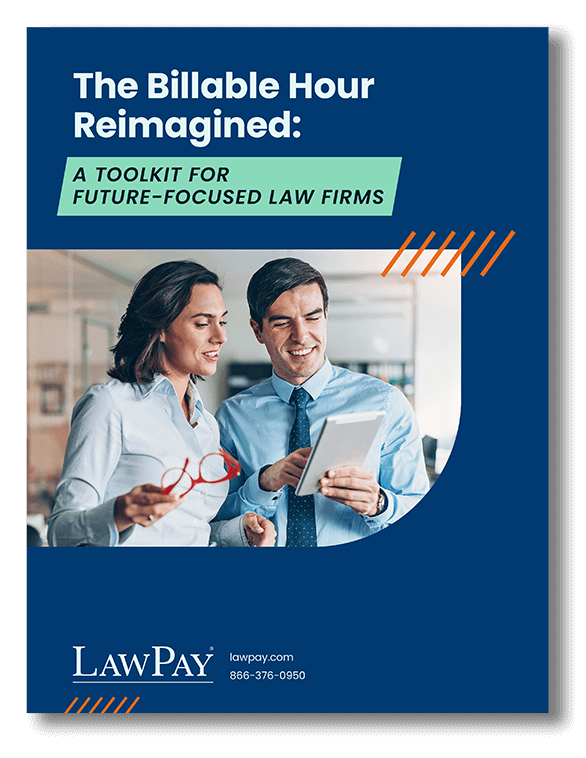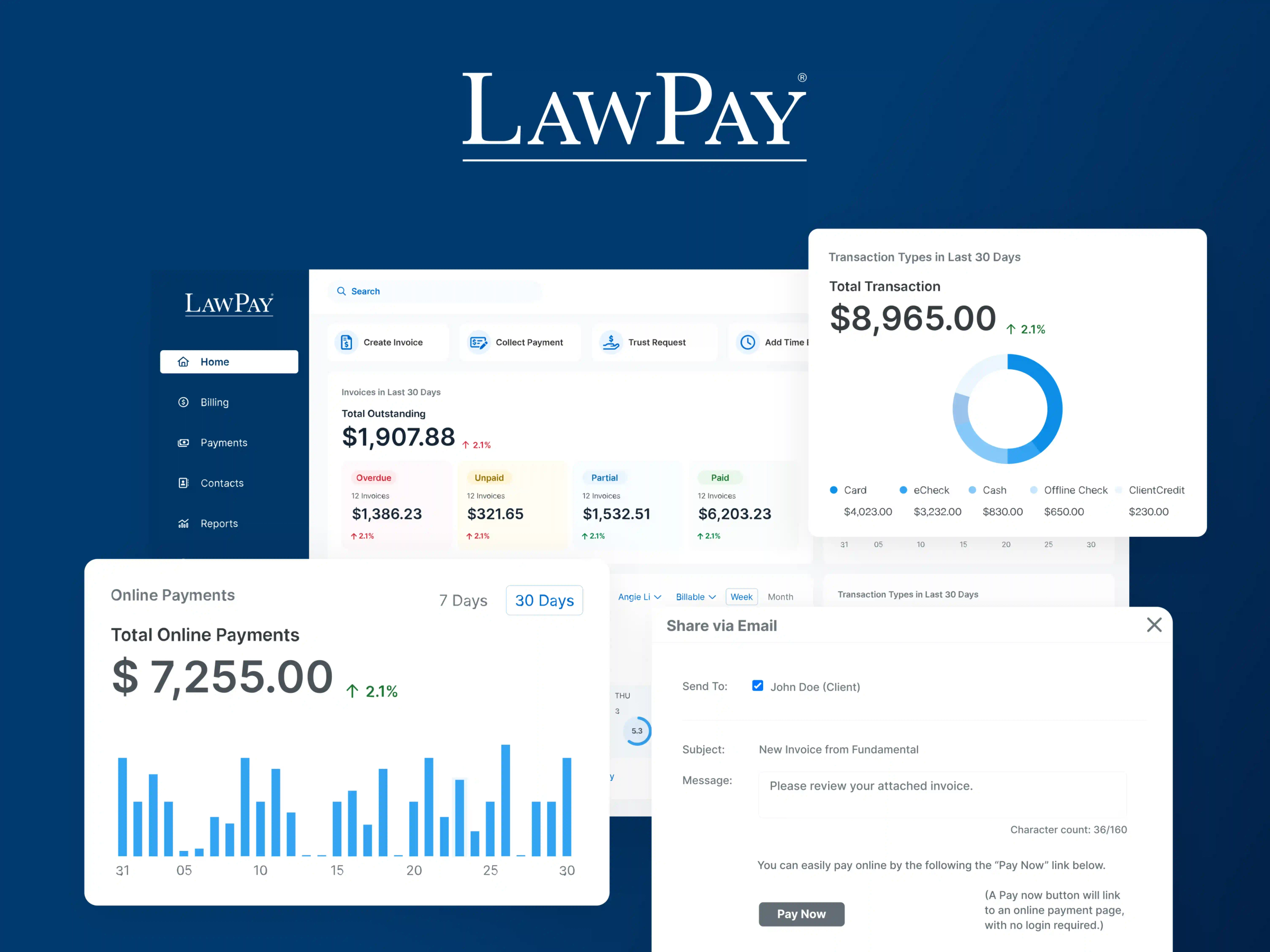While it’s still common for law firms to charge on an hourly basis, that type of billing may not suit every client’s or firm’s needs. Alternative fee arrangements offer flexible payment options that law firms can tailor to individual client circumstances.
With today’s clients expecting more convenience and flexibility, there are many reasons for your firm to explore alternative fee agreements. And you’ll be in great company: According to our 2024 Legal Industry Report, 56% of firms offer lawyer payment plans, with 48% of those firms saying they’ve collected more money over the course of their work.
In this article, you’ll learn more about the types of alternative fee arrangements and how they can benefit your firm.
1. Retainer
Lawyer retainers are common alternative fee arrangements for law firms because they offer predictable income and ongoing, as-needed support for your clients. However, there can be drawbacks. Clients may hesitate to pay upfront, and if they don’t feel they received the amount of work expected, they may request a refund.
Example: A corporate client chooses to retain your firm for ongoing advice around employment laws and compliance.
Pros | Cons |
|---|---|
Up-front payment | Clients may hesitate to pay upfront |
Ongoing service for clients | Clients may request refunds |
2. Payment Plans
A payment plan is a type of legal fee arrangement that lets clients make ongoing monthly payments directly to your firm, and it ends whenever they pay the full balance. Your firm and the client will agree upon a payment schedule.
Payment plans provide flexibility to clients, which many clients will appreciate. The downside is that getting the full amount you’re owed may likely take longer.
Example: A family law attorney sets up a payment plan for clients to pay for their divorce case over six months.
Pros | Cons |
|---|---|
More affordable for clients | Requires extra payment tracking |
Improves payment rates | Risk of missing or late payments |
3. Legal Fee Financing
Legal fee financing services allow clients to secure funding for your firm’s work while paying their legal fees in installments. This occurs through a partnership with a third-party lender, who pays your firm the full invoiced amount upfront and takes ongoing payments from the client.
Example: A personal injury firm offers legal fee financing to clients needing immediate representation.
Pros | Cons |
|---|---|
The firm is paid upfront | Clients must pay back with interest |
More accessible for clients | Firms often must partner with a financing provider |
4. Subscription Fees
A subscription fee works the same way in a legal setting as it does with a streaming service or an athletic club—you get access to something in exchange for a set recurring amount, usually paid monthly.
This arrangement can make your services more affordable, gives your firm more consistent, ongoing revenue, and offers a way to develop lasting relationships with clients.
Example: A firm offers a small business subscription to cover contract reviews and compliance.
Pros | Cons |
|---|---|
More affordable services for clients | Can be challenging to determine the right subscription structure |
Provides consistent, ongoing revenue | Won’t suit all practice areas |
5. Fixed or Flat Fees
Also known as “fixed fees,” flat fees are a type of lawyer fee in which the client agrees to a single, predetermined price at the outset of a more transactional project. Rather than charging hourly to draft a will or contest a traffic ticket, for example, you’d simply quote a reasonable figure to handle that particular task from start to finish.
The biggest advantage of this approach is pricing transparency. The client won’t be confused or surprised by a bill that’s larger than expected, which will help foster trust and a positive client experience.
But you have to think carefully about your flat rates. If a task takes five times longer than expected, you could receive a much smaller payout than if you had opted for the standard hourly billing approach.
Example: An attorney charges a set amount, perhaps $1,500, for an estate planning package.
Pros | Cons |
|---|---|
Pricing transparency | Risks underpricing more complex cases |
Simpler billing |
6. Unbundled Legal Services
Another unique type of lawyer fee is an unbundled legal service. In this situation, clients pay for the lawyer to complete specific tasks rather than across-the-board legal representation.
For instance, a client looking for support with estate planning or immigration may not need the whole gamut of legal representation and prefer paying for only the help they need. Clients with some legal knowledge may also choose to represent themselves in court but seek your help with document oversight.
Example: A client hires an attorney to draft documents but plans to represent themselves in court.
Pros | Cons |
|---|---|
More affordable for clients | Clients may struggle without full representation |
Increases client access to legal services |
7. Contingency Fees
With a contingency fee arrangement, your compensation is a percentage of the client’s payout, assuming their case is successful.
These types of legal fees are a popular choice in situations where the case is large and complex, and the client may not be able to afford a big legal fee—such as a case where a person is suing a hospital for a botched surgery.
The advantage to a contingency fee is that your payout could be substantial if you’re victorious in court. Like other alternative fee arrangements, it also puts your services within reach of people who cannot afford them otherwise.
Of course, if you lose, you’ll receive no payment for your work. Contingency fees can also be fraught with ethical problems. They're not allowed in certain types of cases and regulations can vary between states.
Example: Your firm agrees to receive 30% of a $100,000 settlement with a hospital.
Pros | Cons |
|---|---|
No upfront cost for clients | No payment if the case is lost |
Incentivizes attorneys to win | Can lead to selective case acceptance |
8. Success Fees
The success fee is closely related to the contingency fee. With a success fee, your firm generally charges a predetermined compensation amount regardless of the case’s outcome. However, if you win, you will also be entitled to additional compensation.
For example, in a high-stakes litigation situation, your firm might charge a small amount upfront but expect a much larger sum upon a favorable case outcome. However,success fees are best implemented when you have full confidence in your ability to win the case.
Example: Your firm charges $10,000 upfront plus a $60,000 success fee upon winning the case.
Pros | Cons |
|---|---|
Reduces client risks | Can be tricky to structure fairly |
Incentivizes success |
9. Capped Fees
A capped-fee arrangement borrows elements of both hourly billing and flat fees. In this instance, you may charge your customary hourly rate while agreeing in advance that your total bill will not exceed a predetermined amount.
Example: Your firm charges the standard hourly rate but guarantees the client’s final bill will not exceed $50,000.
Pros | Cons |
|---|---|
Cost certainty for clients | May result in underpricing of complex work |
Keeps your standard hourly rate |
10. Sliding Scale Fees
Sliding scale arrangements allow you to tailor your rates to the specific details of a client’s circumstances.
You can leverage a sliding scale arrangement based on the volume of work. For example, you might charge $1,500 for standard estate planning but only $1,000 if the client has fewer needs and only $500 to simply review a will.
You may also apply a sliding scale to your hourly rates. For example, you could charge $200 an hour for a client that makes well over six figures and $85 an hour for a client of more modest means. The main advantage of this approach is that it will allow you to serve clients who may desperately need legal help but may be unable to afford your services otherwise.
Example: A firm charges lower fees for clients with lower incomes.
Pros | Cons |
|---|---|
Increases clients’ access to legal services | Leads to inconsistent revenue |
Can attract a more diverse pool of clients |
11. Blended Fees
Blended fees are just what they sound like—a blend of hourly billing and other structures. For instance, you might combine a flat fee structure for routine or transactional work (like drafting contracts) with an hourly rate for more complex work (like negotiations). You can also factor in success fees for positive outcomes and capped fees to provide your client an upper limit on costs.
Example: Your firm charges a fixed fee of $50,000 for initial contract drafting and due diligence, plus a standard hourly rate of $500 for additional negotiations or added complications.
Pros | Cons |
|---|---|
More flexibility | Can be difficult to structure fairly |
Balance of risk and reward | Higher administrative burden |

12. Fee Collar
A fee collar is a type of legal alternative fee arrangement (AFA) that caps legal fees but still allows for adjustments as needed based on effort. In practice, this means that if costs exceed an agreed-upon target, adjustments may apply.
Typically, this includes a baseline fee estimate for the project plus a collar range—the buffer above and below the base estimate. Additionally, you can include a formula for handling excess costs or savings.
Example: Your firm estimates total costs at $100,000 for litigation, adding a 10% fee collar. If fees remain between $90,000-$100,000, the client pays the actual cost. If they exceed $110,000, the firm absorbs a portion of the excess and if they fall below $90,000, the client may pay a portion of the difference.
Pros | Cons |
|---|---|
Blends predictability and flexibility | Can be complex to negotiate |
Aligns incentives for firms and clients | Can lead to disputes or client confusion |
13. Legal Secondment
Legal secondments involve embedding an attorney into a client's organization for a set period, letting them work directly as part of the client's team while remaining employed by the law firm. The firm pays the attorney's salary and bills the client at an agreed-upon rate.
Example: Your firm assigns an attorney to a client for a six-month period. During this time, the attorney works as part of the client's legal team, and your firm bills the client at a predetermined pay rate.
Pros | Cons |
|---|---|
Integration with client operations | Not scalable for small firms |
Improved client relationships |
14. Phased Budgets
Using a phased budget, your firm will bill for set project stages based on agreed-upon cost estimates. This arrangement, often used in large litigation cases with multiple phases, lets you charge separately for different parts of the process, such as investigation, filing, and trial work.
Example: Your firm bills separately for case investigation, case filing, and trial proceedings.
Pros | Cons |
|---|---|
Transparency | Requires careful tracking |
Better budget control |
15. Portfolio Fixed Fee
A portfolio fixed fee arrangement involves a fixed price covering legal matters throughout a defined period. The client and firm agree on the scope, the time frame, and a fair fee based on workload and expected outcomes.
Here are a few situations where you might consider such a package:
Employment law: Handling all employee-related matters, including contracts, disputes, and compliance with labor laws.
Intellectual property management: Overseeing trademark filings and patent applications.
Regulatory compliance: Ensuring adherence to industry regulations over time.
Litigation defense: Handling recurring lawsuits like product liability or labor disputes.
Mergers and acquisitions: Offering ongoing counsel for structuring deals, due diligence, and negotiations.
Example: Your firm charges a company a fixed $500,000 annual fee for all matters related to employment rather than paying per case.
Pros | Cons |
|---|---|
Fosters long-term client relationships | Doesn’t always account for complexity or unexpected challenges |
Fixed costs |
What Alternative Payment Methods Can Law Firms Offer?
Because clients each have unique needs and challenges, there isn’t a one-size-fits-all payment process. Luckily, in addition to alternative fee arrangements, your firm can offer plenty of payment methods.
These include:
eCheck: An electronic check, or eCheck, is a digital version of a paper check. This method is great for clients who prefer more traditional payments. These carry lower fees than credit cards and process faster than paper checks.
ACH transfer: Direct payments between bank accounts using the Automated Clearing House (ACH) network bring high security, low fees, and strong reliability.
Credit or debit: Credit and debit cards allow for instant payments and are convenient and widely used by clients. However, you should be aware of the rules around how firms can process credit card payments—such as being prohibited from passing processing fees onto clients.
Online payment platforms: Platforms like LawPay offer secure payment processing for clients, allowing 24/7 payments, automated receipts, and a high degree of self-service.
Mobile payments: Apps like Apple Pay, Google Pay, Venmo, or PayPal let clients pay instantly with their phone or digital wallet. This method is fast, convenient, and best for small payments or retainers. Before choosing a mobile payment method, confirm that it complies with legal payment processing rules.
Third-party financing: The aforementioned legal fee lending programs also serve as a payment method. In this method, the third-party lender pays your firm and allows the client to repay over time.
What Are The Advantages of Alternative Fee Arrangements for Law Firms?
Innovative legal companies pioneered alternative billing arrangements for lawyers because they have many unique advantages over hourly billing. Learn more about these advantages to decide whether you want to incorporate an alternative fee arrangement in your law firm.
Better Billing and Collection Workflows
An important part of running a successful legal practice is actually getting paid. This involves sending and processing effective invoices, following up with clients, and collecting your fees.
Alternative fee arrangements cangreatly simplify and streamline this work, providing a huge competitive advantage. For example, consider a flat fee: charging a single, standard rate for legal services makes billing for those services as simple as possible—the number is always the same and doesn’t change based on factors like the number of hours worked.
These advantages only get bigger when paired with industry-leading e-billing software for law firms, such as LawPay. LawPay makes it easy to handle the financial side of running a law firm by offering attorney fee agreement templates and helping with drafting a fee agreement, among other things.
Greater Price Transparency
Transparency in your law firm’s pricing is another best practice that will satisfy clients. Offering alternative fee arrangements can accomplish this goal and help to set your firm apart from the competition. For instance, hourly billing may work for a specific client case, but may not be transparent enough in others.
In this scenario, if you charge a flat rate, a subscription fee, or a success fee, it clears up some of the confusion. A single dollar amount (or percentage) is explained to the client upfront, and they can decide in advance whether or not they agree to the charge to the payment method.. This also often positively impacts your realization rate, too, which is the amount of the earned money you actually receive.
Improved Client Trust and Satisfaction
People in need of legal assistance generally face some large-scale challenge in their lives, such as a divorce, injury, or another legal battle. Earning their trust and helping them feel seen and understood will go a long way toward establishing your reputation and ensuring your future success.
Providing alternative fee arrangements for these clients can help set your firm apart and earn trust. By offering a variety of different ways to pay for your services, you’ll be able to serve a broader customer base by offering payment options that work for them.
How Can Law Firms Solve Common Issues With Alternative Fee Arrangements?
Alternative fee arrangements solve problems for firms and clients alike, from increasing your firm’s revenue to enhancing flexibility. Here are a few of the most common issues.
Scope creep occurs when the case takes more time or effort than expected (but the fee remains the same). An alternative fee arrangement that blends a fixed fee with your hourly rate can ensure you get paid for any extra work that arises.
Underpricing your work puts you at risk of income loss, but you can address this by factoring in complexity when setting your fees.
Unpredictable or low revenue can be stabilized by instituting legal AFAs, letting you tailor billing to the client’s needs, and improving the chances of on-time payment collection.
How Legal Billing Software Can Help With Managing Alternative Fee Arrangements
As digital services and diverse payment methods become more common, lawyers are adapting their billing practices to better serve clients. Offering customized alternative fee arrangements can help improve client satisfaction while also improving your law firm’s profitability. Leveraging the right software can help your law firm more easily manage these tailored fee agreements without spending more time on non-billable work.
LawPay’s legal billing software is purpose-built to offer greater flexibility in how lawyers structure their fee arrangements, freeing you up to think about how best to run your legal practice. Schedule a live LawPay demo today to learn more.
Schedule a demo to see what LawPay can offer your firm.
Get a demo
About the author

Trent Fowler
